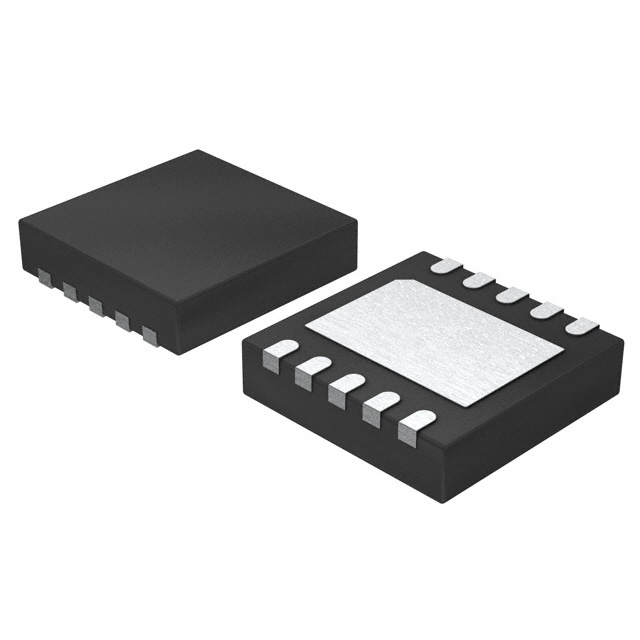Voir les spécifications pour les détails du produit.

LTC2626CDD#PBF
Product Overview
Category
The LTC2626CDD#PBF belongs to the category of digital-to-analog converters (DACs).
Use
It is primarily used for converting digital signals into analog voltage outputs.
Characteristics
- High precision and accuracy
- Low power consumption
- Wide operating temperature range
- Small form factor
- Easy integration with microcontrollers
Package
The LTC2626CDD#PBF comes in a DFN-10 package, which stands for Dual Flat No-Lead. This package offers a compact size and excellent thermal performance.
Essence
The essence of the LTC2626CDD#PBF lies in its ability to provide accurate analog voltage outputs based on digital input signals.
Packaging/Quantity
This product is typically packaged in reels or tubes, with a quantity of 250 units per reel/tube.
Specifications
- Resolution: 12 bits
- Number of Channels: 1
- Supply Voltage Range: 2.7V to 5.5V
- Output Voltage Range: 0V to Vref
- Operating Temperature Range: -40°C to 85°C
- Interface: SPI-compatible
Detailed Pin Configuration
The LTC2626CDD#PBF has the following pin configuration:
- VDD: Power supply voltage
- GND: Ground reference
- CS: Chip select input
- SCK: Serial clock input
- SDI: Serial data input
- LDAC: Load DAC input
- REF: Reference voltage input
- AGND: Analog ground reference
- OUT: Analog voltage output
- NC: No connection
Functional Features
- High-resolution digital-to-analog conversion
- Fast settling time
- Low glitch energy
- Power-on reset
- Daisy-chainable for multiple devices
Advantages and Disadvantages
Advantages
- High precision and accuracy in analog voltage outputs
- Low power consumption, suitable for battery-powered applications
- Wide operating temperature range allows for use in various environments
- Small form factor enables integration into space-constrained designs
- Easy integration with microcontrollers through SPI interface
Disadvantages
- Limited to single-channel output
- Requires external reference voltage source
Working Principles
The LTC2626CDD#PBF utilizes a digital-to-analog conversion technique to convert the digital input signals into corresponding analog voltage outputs. It employs an internal reference voltage and a high-resolution DAC to achieve accurate conversion.
Detailed Application Field Plans
The LTC2626CDD#PBF finds applications in various fields, including:
- Industrial automation: Precise control of analog signals in industrial processes.
- Test and measurement equipment: Generating accurate analog test signals.
- Audio equipment: Providing high-quality analog audio outputs.
- Instrumentation: Calibration and control of analog sensors.
Detailed and Complete Alternative Models
- LTC2620: 12-bit DAC with multiple channels.
- LTC2630: 10-bit DAC with integrated reference voltage.
- LTC2645: 16-bit DAC with low noise performance.
These alternative models offer different features and specifications to cater to specific application requirements.
Word count: 441 words
Énumérez 10 questions et réponses courantes liées à l'application de LTC2626CDD#PBF dans les solutions techniques
Sure! Here are 10 common questions and answers related to the application of LTC2626CDD#PBF in technical solutions:
Q: What is LTC2626CDD#PBF? A: LTC2626CDD#PBF is a digital-to-analog converter (DAC) chip manufactured by Linear Technology (now part of Analog Devices). It is used to convert digital signals into analog voltages.
Q: What is the resolution of LTC2626CDD#PBF? A: LTC2626CDD#PBF has a resolution of 12 bits, which means it can represent analog voltages with a precision of 1 part in 4096.
Q: What is the operating voltage range of LTC2626CDD#PBF? A: LTC2626CDD#PBF operates from a single supply voltage ranging from 2.7V to 5.5V.
Q: How many channels does LTC2626CDD#PBF have? A: LTC2626CDD#PBF has 4 independent DAC channels, allowing you to control up to 4 analog outputs simultaneously.
Q: What is the output voltage range of LTC2626CDD#PBF? A: The output voltage range of LTC2626CDD#PBF is programmable and can be set between 0V and VREF, where VREF is the reference voltage supplied to the chip.
Q: Can LTC2626CDD#PBF operate in both unipolar and bipolar modes? A: Yes, LTC2626CDD#PBF can be configured to operate in either unipolar mode (0V to VREF) or bipolar mode (-VREF/2 to +VREF/2).
Q: What is the interface used to communicate with LTC2626CDD#PBF? A: LTC2626CDD#PBF supports a standard 3-wire SPI (Serial Peripheral Interface) for communication with microcontrollers or other digital devices.
Q: Does LTC2626CDD#PBF have an internal reference voltage? A: No, LTC2626CDD#PBF requires an external reference voltage (VREF) to set the output voltage range.
Q: Can LTC2626CDD#PBF be used in battery-powered applications? A: Yes, LTC2626CDD#PBF has a low power consumption and can be used in battery-powered applications where power efficiency is important.
Q: Are there any evaluation boards or development kits available for LTC2626CDD#PBF? A: Yes, Analog Devices provides evaluation boards and development kits that can help you quickly prototype and test your LTC2626CDD#PBF-based solutions.

